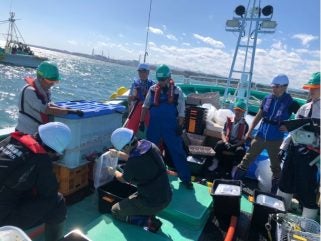
The International Atomic Energy Agency (IAEA) is taking the first practical steps towards additional monitoring near the Fukushima Daiichi NPP in Japan. The IAEA carried out marine sampling as an initial step, leveraging the presence of experts from various countries who were in Japan for a mission to collect samples for the latest IAEA interlaboratory comparison (ILC) related to the ALPS treated water discharge.
Contaminated water, used to cool the melted reactor cores in the aftermath of the 2011 nuclear disaster at Fukushima, is stored in around 1,000 huge tanks at the plant before being treated by the Advanced Liquid Processing System (ALPS), which removes most of the radioactive contamination, with the exception of tritium.
The treated water is then stored in separate tanks before being diluted with seawater to one-fortieth of the concentration permitted under Japanese safety standards prior to being released one kilometre off the power plant. As a result, tritium levels fall below national regulations. The water is being discharged in batches over a period of approximately 30 years. The first discharge took place in August 2023.
The IAEA’s new measures follow announcements in September by China and Japan that indicated their mutual agreement to implement additional measures, which will facilitate wider participation of other stakeholders under the framework of the IAEA. The Agency confirms that this agreement is built on its existing sampling and monitoring activities in compliance with the IAEA statutory functions.
International experts from China’s Third Institute of Oceanography, the Korea Institute of Nuclear Safety and Switzerland’s Spiez Laboratory – members of the IAEA’s Analytical Laboratories for the Measurement of Environmental Radioactivity (ALMERA) network – participated in the marine sampling, which included taking samples for subsequent analysis in their own laboratories.
“The Agency will continue to coordinate with Japan and other stakeholders, including China, to ensure that the additional measures are implemented appropriately under the framework of the IAEA, maintaining the integrity of the process with full transparency to ensure that water discharge levels are, and will continue to be, in strict compliance and consistent with international safety standards,” said IAEA Director General Rafael Mariano Grossi.
The IAEA said it views this mission as a timely opportunity to initiate the first practical steps towards full implementation of the additional measures. “The Agency will continue its impartial, independent and objective safety review during the discharge phase, by having a continuous onsite presence, corroborating monitoring data through ILCs and providing live online monitoring. The IAEA will continue liaising at the technical level to ensure smooth implementation of the additional measures.”






